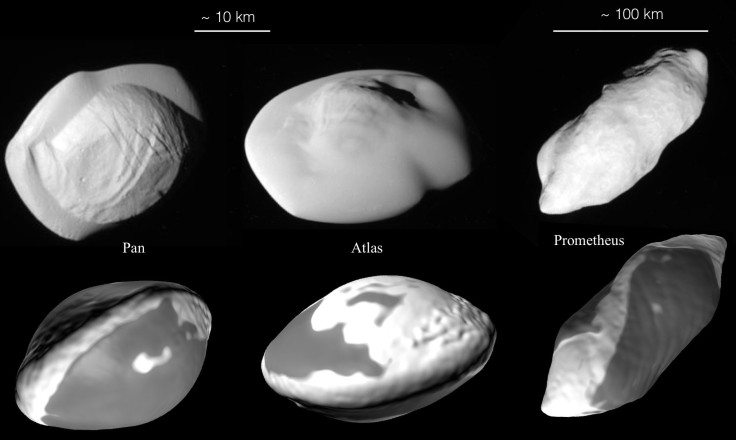Saturn's Inner Moons Have Weird Shapes, But Why?

Saturn, the ringed giant in the outer solar system, is full of mysteries. NASA’s Cassini helped us understand the planet to some extent, but when the spacecraft, which ended its 13-year long mission last year, took the closest images of its inner moons, scientists were puzzled.
The space objects were not just tiny but also had odd structures. For instance, Pan and Atlas have large ridges and bulbous centers and look a lot like cosmic ravioli, while 90-km long Prometheus looks more like a stretched potato. The unusual shapes have led many think to think how the objects got to be like this and not like Earth’s perfectly spherical moon.
As the early days of our solar system, when planets first came to be, were extremely chaotic, scientists have had many explanations to justify the weird shapes of these moons. However, none of those theories could explain the complete range of their strange structure or size, Space.com reported.
This is why Martin Jutzi and Adrien Leleu, astrophysicists from the University of Bern in Switzerland, took up the task to explain the formation and evolution of the moons over time.
First, the researchers ran a bunch of basic tests and ruled out one of the most common theories explaining the formation of celestial bodies – gradual accretion of material around a core. According to the duo, Saturn’s mass 95 times more than that of Earth and the ringed planet’s inner moons orbit way too close to it, approximately at a distance less than half the distance between Earth and its moon.
That said, at such proximity, the strong gravitational pull from Saturn would have generated tidal forces strong enough to pull the moons apart. This confirmed moons couldn’t have formed with such shapes through the accumulation of materials. However, follow-up simulations focusing on an alternative model called pyramidal regime revealed that the moons formed from a series of collisions between several tiny moonlets of the same size.
In the simulations, the researchers demonstrated the collisions between these moonlets results in structures that look very similar to the inner moons. Essentially, direct head-on collisions led to the formation of flattened structures with large equatorial ridges like those observed on Atlas and Pan, while oblique moonlet impacts resulted in elongated objects like Prometheus.
"We found that 20 to 50 percent of the small moons should display either an equatorial ridge or an elongated shape, while the rest should have more random potato-like shapes," Leleu told Space.com. "And this is the case. Considering the six inner moons Pan, Atlas, Prometheus, Pandora, Janus and Epimetheus, the first three display these features, while the others — Pandora, Janus, and Epimetheus — have random shapes."
Though the current orbital path of the moons and their environment hints that the collisions would have happened with a velocity of around 35km/hr, the work also indicates that the head-on collisions would have been more frequent.
"A significant fraction of such merging collisions take place either at the first encounter or after 1-2 hit-and-run events," the authors summarize in the study. "In this respect, Saturn is almost a toy system to study these processes," Martin Rubin, co-author of the study, said in a statement.
The study, titled "The peculiar shapes of Saturn’s small inner moons as evidence of mergers of similar-sized moonlets," was published May 21 in the journal Nature Astronomy.
© Copyright IBTimes 2024. All rights reserved.





















